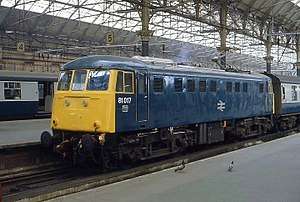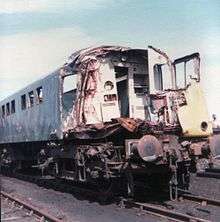British Rail Class 81
The British Rail Class 81 is an AC electric locomotive that formerly operated on the West Coast Main Line of the London Midland Region of British Rail. Originally designated AL1, it was the first type of AC electric locomotive to be delivered to British Railways.
| British Railways AL1 British Rail Class 81 | |||||||||||||||||||||||||||||||||||||||||||||||||||||||||
|---|---|---|---|---|---|---|---|---|---|---|---|---|---|---|---|---|---|---|---|---|---|---|---|---|---|---|---|---|---|---|---|---|---|---|---|---|---|---|---|---|---|---|---|---|---|---|---|---|---|---|---|---|---|---|---|---|---|
 81017 at Manchester Piccadilly | |||||||||||||||||||||||||||||||||||||||||||||||||||||||||
| |||||||||||||||||||||||||||||||||||||||||||||||||||||||||
| |||||||||||||||||||||||||||||||||||||||||||||||||||||||||
| |||||||||||||||||||||||||||||||||||||||||||||||||||||||||
| |||||||||||||||||||||||||||||||||||||||||||||||||||||||||
History
As part of the modernisation of the West Coast Main Line, which included electrification, 100 locomotives of five types were acquired; each type from a different manufacturer.
The first locomotives to be delivered were type AL1, designed by British Thomson-Houston (BTH), an order being placed for 25 examples. Of these, 23 were for use on passenger trains with a top speed of 100 mph and were designated Type A. The other two locomotives were intended for freight train use, and geared for a top speed of 80 mph, these were designated Type B.[4]
Before the work was completed, BTH amalgamated with Metropolitan Vickers to form AEI (Associated Electrical Industries) traction division[4] and it was under this name that the locomotives were built in 1959 under subcontract by Birmingham Railway Carriage & Wagon in Smethwick. The first locomotive, E3001, was handed over to British Railways on 27 November 1959.[5] The type was initially used for crew training on the Styal Line between Manchester and Crewe.
The AL1 were numbered E3001 - E3023 and E3096 / E3097; the first twenty-three being Type A and the last two Type B (numbered E3301 and E3302).[6] However, these last two were actually geared for passenger service, being delivered in February 1964 as E3096 and E3097.
Power supply
The locomotives always worked on power provided by overhead catenary, energised at 25,000 V AC. However, the main transformer, normally operated with the four windings in series, could be operated at 6250V AC with the transformer windings in parallel.[4] This voltage was initially to be used where limited clearances gave concern over use of the higher voltage. However, this approach was never used on the West Coast main line, although it was employed elsewhere such as Glasgow Central in the initial 'Blue Train' electrification there. By the time the WCML wiring was extended to Glasgow, it had been revised there to the mainstream 25 kV voltage.
Operations
The class only operated on the West Coast Main Line because they were restricted to lines electrified at 25 kV AC. Cities where these engines could be seen included London, Birmingham, Manchester, Liverpool and Glasgow. They operated passenger, freight and parcel trains. There is no record of operation on the ex-Great Eastern line, which was being electrified at the time of their introduction, nor subsequently on the East Coast Main Line (ECML) when that was electrified in the 1980s.
Early withdrawals
Three locomotives (E3002, E3009 and E3019) were withdrawn before they could be renumbered under the TOPS system. E3002 and E3019 were damaged by fire and both were scrapped at British Rail Crewe Works. The remains of E3009 were also cut up at Crewe Works, the locomotive having been wrecked in the Hixon rail crash of January 1968. These were ‘replaced’ by Class 87s 87033-5.
Renumbering
Under the TOPS system, twenty-two examples were reclassified as class 81 and numbered 81001 - 81022.
Accidents and incidents

- 6 January 1968: locomotive No. E3009 collided with an abnormal load at Hixon, Staffordshire, while hauling an express passenger train. Eleven people were killed and 45 were injured. The locomotive was declared a write-off and subsequently scrapped.
- 9 December 1982: locomotive 81 016 was involved in an accident near Linslade, Buckinghamshire. It was officially withdrawn in 1983.
- 26 August 1983: locomotive 81 001 was damaged by fire near Carstairs, Lanarkshire whilst working a Motorail train.
Withdrawal

Over the years, examples of this class were withdrawn from service following the arrival of newer and more reliable Class 87 locomotives. The Class was fully withdrawn as a result of the arrival of new Class 90 locomotives. The final examples were used for the transfer of empty coaches between London Euston and Willesden sidings between 1989 and 1991. The last two examples withdrawn from service were 81012 and 81017. The majority of the class were scrapped at Coopers Metals in Sheffield.
Preservation
One example, 81002, has been preserved by the AC Locomotive Group, located at Barrow Hill Engine Shed.
Fleet details
| Key: | Preserved | Scrapped |
|---|
| Numbers | AEI Works Number[7] | Date Introduced[7] | Withdrawn[8][9] | Final Depot | Disposal[8] | |||
|---|---|---|---|---|---|---|---|---|
| Type B | Type A[7] | TOPS[7] | Location | Date | ||||
| - | E3001 | 81001 | 1083 | December 1959 | July 1984 | GW | Fire damaged Scrapped at Crewe Works |
September 1986 |
| - | E3002 | - | 1084 | January 1960 | November 1968 | ACL | Fire damaged Scrapped at Crewe Works |
January 1969 |
| - | E3003 | 81002 | 1085 | February 1960 | October 1990 | WN | Preserved at Barrow Hill Engine Shed | |
| - | E3004 | 81003 | 1086 | April 1960 | March 1988 | GW | Scrapped at Coopers Metals, Sheffield | November 1991 |
| - | E3005 | 81004 | 1087 | May 1960 | April 1990 | WN | Scrapped at MC Metals, Glasgow | May 1992 |
| - | E3006 | 81005 | 1088 | July 1960 | February 1989 | GW | Scrapped at Coppers Metals, Sheffield | November 1991 |
| - | E3007 | 81006 | 1089 | August 1960 | October 1988 | GW | Scrapped at Coopers Metals, Sheffield | November 1991 |
| - | E3008 | 81007 | 1090 | October 1960 | February 1990 | GW | Scrapped at Coopers Metals, Sheffield | November 1991 |
| - | E3009 | - | 1091 | October 1960 | August 1968 | ACL | Accident damaged Scrapped at Crewe Works |
August 1968 |
| - | E3010 | 81008 | 1092 | November 1960 | March 1988 | GW | Scrapped at Coopers Metals, Sheffield | November 1991 |
| - | E3011 | 81009 | 1093 | December 1960 | February 1990 | WN | Scrapped at Coopers Metals, Sheffield | December 1991 |
| - | E3012 | 81010 | 1094 | December 1960 | May 1990 | WN | Scrapped at Coopers Metals, Sheffield | November 1991 |
| - | E3013 | 81011 | 1095 | December 1960 | April 1989 | GW | Scrapped at Coopers Metals, Sheffield | November 1991 |
| - | E3014 | 81012 | 1096 | December 1960 | July 1991 | WN | Scrapped at Coopers Metals, Sheffield | December 1991 |
| - | E3015 | 81013 | 1097 | December 1960 | October 1989 | GW | Scrapped at Coopers Metals, Sheffield | November 1991 |
| - | E3016 | 81014 | 1098 | March 1961 | March 1988 | GW | Scrapped at Coopers Metals, Sheffield | November 1991 |
| - | E3017 | 81015 | 1099 | May 1961 | December 1984 | GW | Scrapped at MC Metals, Glasgow | May 1992 |
| - | E3018 | 81016 | 1100 | March 1961 | July 1983 | GW | Accident damaged Scrapped at Crewe Works |
January 1985 |
| - | E3019 | - | 1101 | April 1961 | July 1971 | ACL | Fire damaged Scrapped at Crewe Works |
October 1971 |
| - | E3020 | 81017 | 1102 | May 1961 | July 1991 | WN | Scrapped at Coopers Metals, Sheffield | November 1991 |
| - | E3021 | 81018 | 1103 | June 1961 | January 1986 | GW | Scrapped at MC Metals, Glasgow | June 1992 |
| - | E3022 | 81019 | 1104 | October 1961 | January 1989 | GW | Scrapped at Coopers Metals, Sheffield | November 1991 |
| - | E3023 | 81020 | 1105 | February 1962 | July 1987 | GW | Scrapped at Coopers Metals, Sheffield | November 1991 |
| (E3301) | E3096 | 81021 | 1106 | June 1962 | April 1987 | GW | Scrapped at MC Metals, Glasgow | July 1992 |
| (E3302) | E3097 | 81022 | 1107 | February 1964 | July 1987 | GW | Scrapped at Crewe Works by A Hampton | November 1988 |
References
- Webb & Duncan 1979, p. 6
- Webb & Duncan 1979, p. 27
- Webb & Duncan 1979, p. 28
- Bradley, Roger P (November 1980). "Pioneer AC electrics". Railway Modeller. Vol. 31 no. 360. Beer: Peco Publications & Publicity Ltd. pp. 385–387.
- "Class History – 81". AC Locomotive Group.
- Longhurst 1979, Class AL1–81
- Webb & Duncan 1979, p. 32
- Furness, Ian. "Disposals: Class 81". wnxx. End of the Line: Withdrawn & Stored Locomotives UK. Retrieved 8 January 2009.
- "The Class 81 Fleet". Rail Blue. Retrieved 11 February 2016.
Sources
- Longhurst, Roly (1979). Electric Locomotives of the West Coast Main Line. Truro: D. Bradford Barton Ltd. ISBN 0851533558. OCLC 16491712.CS1 maint: ref=harv (link)
- Webb, Brian; Duncan, John (1979). AC Electric Locomotives of British Rail. David & Charles. ISBN 9780715376638. OCLC 6916046.CS1 maint: ref=harv (link)
Further reading
- Derrick, Kevin (2014). Looking back at AC Electric Locomotives. Strathwood. ISBN 9781905276516. OCLC 931820979.
- Marsden, Colin J. (2007). The AC Electrics. OPC. ISBN 9780860936145. OCLC 148304137.
- McManus, Michael. Ultimate Allocations, British Railways Locomotives 1948 - 1968. Wirral. Michael McManus.
- "AC Type A Electric Locomotives for British Railways, No E3001-E3023". The Railways Archive. Publisher: Associated Electrical Industries Ltd.
External links
| Wikimedia Commons has media related to British Rail Class 81. |